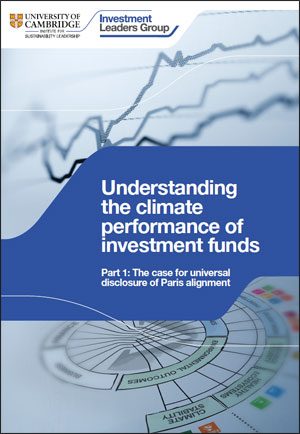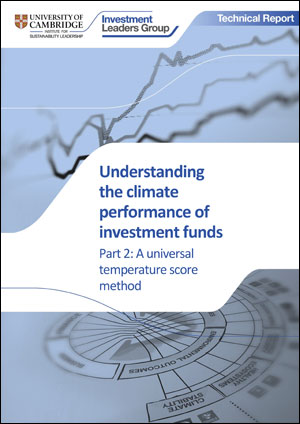29 July 2021 – Understanding the climate performance of investment funds should be made simple to all investors. Analysis from CISL’s Investment Leaders Group (ILG) found that the present disclosure of fund performance does not allow investors to understand and compare the alignment of funds with the Paris Agreement on climate change.
The latest reports from the group now provides a tour of the assumptions and approaches behind existing methods, and introduces a simple and transparent disclosure method that enables investment managers to report the alignment of their portfolios with the Paris ambition.
Watch the webinar held on 23 September 2021
Investors are increasingly turning their attention to climate change, seeking to mitigate climate risks in their portfolios, gain exposure to assets offering climate solutions, and generally have a positive impact upon the world's most serious long-term threat. The base metric for climate stability proposed by the Sustainable Investment Framework utilises total greenhouse gas (GHG) emissions (Scope 1 and 2) as the reporting metric. Although greenhouse gas reporting offers a snapshot of emissions performance, it does not show whether an asset's emissions path is consistent with the Paris ambition. The ideal metric - a temperature score - offers a meaningful, outcome-based number in degrees centigrade (°C) that reveals instantly how a fund aligns with the Paris ambition.
Part 1 of the report analyses the approaches currently used to measure and report investment funds' climate performance and makes a case for temperature score to act as a universal measure of climate performance for the industry.
Download Part 1 of the report
Part 2 aims to foster familiarity with the temperature score landscape by examining the building blocks of existing methods. The report proposes a simple, transparent and scientifically robust method that translates portfolio emissions into a metric expressed in degrees Celsius, to report portfolio alignment with the Paris ambition. The method aims to answer the question: “What would be the global mean temperature increase at the end of the century if the entire economy had the same emissions intensity as this portfolio?”.
The method can also be tailored to perform different functions – general reporting, investment analysis and sector-specific analysis – reflecting the diversity of use cases for temperature scores. Whilst the provision of a simple, universal and fully transparent climate reporting metric is the primary objective of this report, a sectoral approach using E3ME data from Cambridge Econometrics is also offered, for those requiring a more detailed picture of future decarbonisation pathways at the sectoral level.
Download Part 2 of the report
About
The Investment Leaders Group (ILG) is a global network of pension funds, insurers and asset managers committed to advancing the practice of responsible investment. It is a voluntary initiative, driven by its members, facilitated by the Cambridge Institute for Sustainability Leadership (CISL), and supported by academics at the University of Cambridge. The ILG's vision is an investment chain in which economic, social and environmental sustainability are delivered as an outcome of the investment process as investors go about generating robust, long-term returns.
Citing these reports
Cambridge Institute for Sustainability Leadership (CISL). (2021). Understanding the climate performance of investment funds. Part 1: The case for universal disclosure of Paris alignment. Cambridge, UK: Cambridge Institute for Sustainability Leadership.
Cambridge Institute for Sustainability Leadership (CISL). (2021). Understanding the climate performance of investment funds. Part 2: A universal temperature score method. Cambridge, UK: Cambridge Institute for Sustainability Leadership.
Legal disclaimer
While these reports are made available by the Cambridge Institute for Sustainability Leadership (‘CISL’), the opinions expressed here are those of the authors and do not represent an official position of CISL, the University of Cambridge, or any of its individual business partners or clients. The University of Cambridge takes no responsibility or liability for the reports or their use except that which it is unlawful to exclude.
These reports are designed for research use only and not for providing information on which to base financial, investment or operational decisions. The use of the information therein is done at your sole risk. The University of Cambridge does not give any warranties or make any representations for the information or results contained or derived from these reports, and to the extent permitted by law, any condition or warranty which would otherwise be implied into these reports is expressly excluded.







